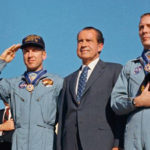Apollo 13: Houston, we have a problem...
Their survival was one of the greatest achievements in American flight of the 20th Century. Their mission has been called “the most successful space failure in history.” The Apollo 13 space mission was launched 47 years ago today, on April 11th, 1970. Its crew didn´t know then what their destiny would be, the dangers they would face, or how famous that phrase would become, as it was broadcast and translated – erroneously – around the world. There was even a movie made about their story.

“Houston, we’ve had a problem here,” – and not “we have” – said a desperate John Swigert, one of the astronauts aboard the Apollo 13, a mission whose goal was to make the third moon landing in history. A few days after taking off from Earth, they had a mishap that nearly cost them their lives: the explosion of the oxygen tanks, along with an accumulation of carbon dioxide due to system errors. If it weren´t for the skill of the crew members themselves – James Lovell –the mission commander, Swigert and Fred Haise - along with the intervention of Gene Kranz, who from his place at Mission Control in Houston, managed to offer them possible solutions, they wouldn´t have survived.
Lovell, of course, knew how to work under pressure. Tom Hanks played him in the 1995 film adaptation of the story, Apollo 13, (Directed by Ron Howard), a film that won two Oscars and left more than one filmgoer holding his breath in the movie theater.
In spite of all the problems the crew had to face, in the end they were able to land in the Pacific Ocean on board the Aquarius, their own peculiar lifeboat. The Aquarius was a lunar module, and not at all prepared for what was to come. It was made for two people, not three and for a trip of 45 hours, not 90 hours, as it turned out to be.
Also, the conditions were hardly optimal: the water and electricity supplies were in bad shape, the temperature reached 3 degrees Celsius (37.4 degrees Fahrenheit) and there was no hot water, so they couldn´t cook the dehydrated food. Another thing vital to the astronauts’ survival was the extraction of carbon dioxide, a problem they solved at the last minute with a full-blown space hack – a makeshift adaptor fashioned out of everything they had on hand, from flight manuals to socks.

It was a happy ending for Apollo 13 crew, pictured here with President Richard M. Nixon - NASA
The crew maintained their cool at all times and always reacted rapidly, as each second counted. That’s why the Omega chronometer that Swigert used to measure the 14 seconds that each ignition should last was also crucial. The Omega watch brand was afterwards given NASA’s Silver Snoopy Award, a prize that, as its name indicates, is named after the character created by cartoonist Charles M. Schulz, a great enthusiast of the space programs. This special award goes to achievements that have contributed to the success and safety of the missions.
“Houston, we have a problem,” quickly turned into a catch phrase that later transcended boundaries to become a popular saying all around the world.